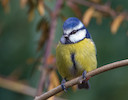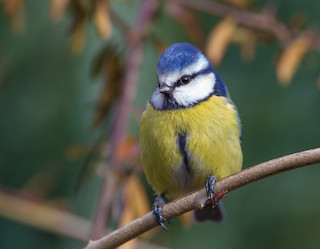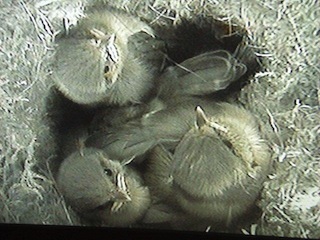 The Blue Tit is one of our most familiar birds, and a frequent visitor to bird tables.
The Blue Tit is one of our most familiar birds, and a frequent visitor to bird tables.
Photo: © Natural England/Allan Drewitt
Scientific name: Cyanistes caeruleus
Conservation status: Least concern on IUCN Red List
 The Blue Tit, one of our most familiar birds due to its propensity to come to bird tables and feeders, is widely distributed across Britain, with over 3.5 million breeding pairs. Found in habitats ranging from woods, hedges and heaths to our own gardens, it is easily recognisable by its blue crown, distinguishing it from the larger Great Tit, which has a black crown. The Blue Tit also has a dark stripe down the middle of its yellow underparts, but which is not as prominent as on the Great Tit.
The Blue Tit, one of our most familiar birds due to its propensity to come to bird tables and feeders, is widely distributed across Britain, with over 3.5 million breeding pairs. Found in habitats ranging from woods, hedges and heaths to our own gardens, it is easily recognisable by its blue crown, distinguishing it from the larger Great Tit, which has a black crown. The Blue Tit also has a dark stripe down the middle of its yellow underparts, but which is not as prominent as on the Great Tit.
Although they enjoy eating peanuts and seeds from feeders, their main summer diet is insects and other invertebrates, but they eat more seeds in the colder months when insects are less available. They use various calls and songs: there is an audio recording on the RSPB website, given in the link below.
 Blue Tits nest in holes in trees, but will happily utilise nest boxes. Clutch size is generally up to 12 eggs, with the female laying one egg per day, and incubation is about two weeks
Blue Tits nest in holes in trees, but will happily utilise nest boxes. Clutch size is generally up to 12 eggs, with the female laying one egg per day, and incubation is about two weeks
*The scientific name of this species is sometimes given as Parus caeruleus. Cyanistes is a relatively new genus name for the species, with Great Tits now being the only British Tits in Parus.
Did you know…?
…both the genus and species names of the Blue Tit mean ‘blue’, but one is from the Greek (Cyanistes) and one from Latin (caeruleus)
…immature Blue Tits can be spotted by their yellow cheeks (adults have white cheeks)
More information and references:
Gooders, J. and Harris, A., 1986. Field Guide to the Birds of Britain and Ireland. Kingfisher Books, London.
Published: June 2013
Author: Amanda Scott
Photos: adult bird, © Natural England/Allan Drewitt; chicks in nest, Steve Townsend
